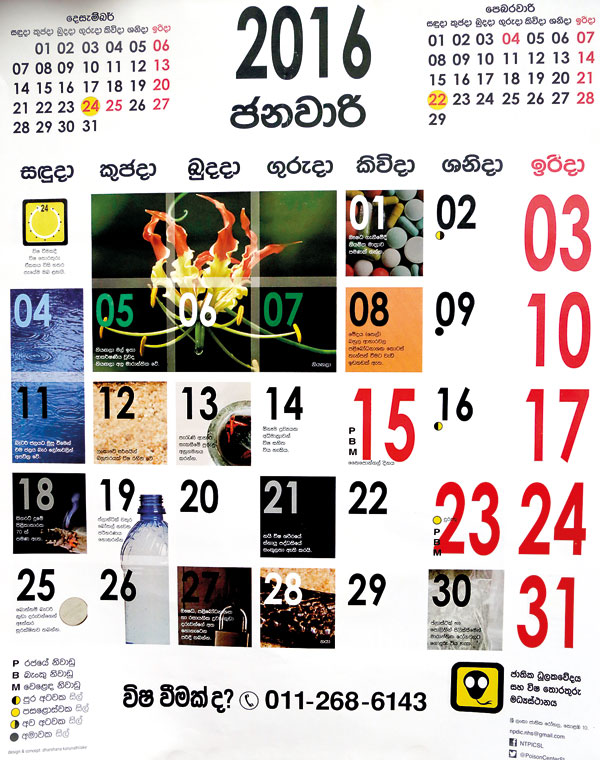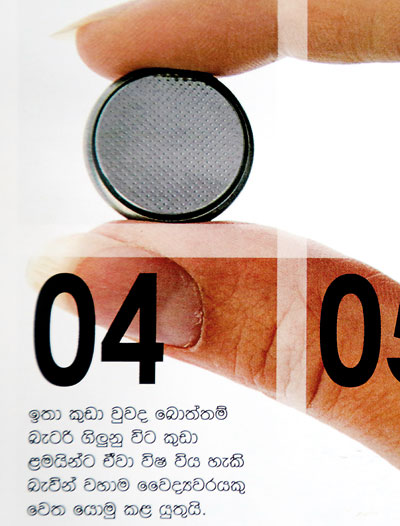News
Auspicious Avurudu present: A litha for your health and safety

Dr. Waruna Gunathilake. Pic by M.A. Pushpa Kumara
A ‘litha’ (almanac) with a difference is in circulation this year, containing not only important days and times for Avurudu and information on poya days but also health alerts.
Dubbed the ‘Visha Nivarana Litha’, the almanac, while including usual details such as the ‘sanwathsara pathraya and pala-pala’, ‘ritta’, ‘shuba davas’, ‘poya labana, gevana welavan’, ‘kaala horawa’ and ‘raahu kaalaya’, has also embedded within it ‘avadhana’ marked with red blobs to grab the attention.
These ‘avadhana’ or points needing attention include:
4Use clay pots and pans to prepare food.
4Try not to re-use oil which has been used for frying food once.
4Use natural ripening methods for bananas
4Don’t use excessive colouring and flavouring when preparing food. Instead use condiments such as curry powder.
4Avoid the use of pesticides around the well.
4Avoid excess sugar and fats. Not only sugar, but jaggery and treacle also increase blood-sugar levels.
4Safeguard children from injuries they can sustain when playing on the swings or lighting fire-crackers.
Innovative and trendsetting, the National Poisons Information Centre based at the National Hospital of Sri Lanka (NHSL) is using the litha and many other means of communication to target different age-groups, to press ahead with health messages.
And it is not only relevant for this season but all throughout the year. Usually, while the litha predicts the fortunes and misfortunes of politicians, the National Poisons Information Centre is providing a heads-up about a rise in household poisoning and snakebite envenomation. 
A colourful and attractive calendar, meanwhile, has been put out at the beginning of the year with health messages and danger warnings.
“Such dissemination of health information is a first in Sri Lanka,” points out Dr. Waruna Gunathilake, Head of the Toxicology & National Poisons Informat ion Centre, explaining that the litha has been distributed among temples in the country and the calendar among schools.
Both the litha and the calendar were creatively designed by Dharshana Karunathilake, he says, commending him for giving of his time and skills free of charge.
NHSL Director Dr. Anil Jasinghe has ordered the replacement of all calendars in the Outpatients’ Department (OPD), various clinics, wards, canteen and doctors’ lounge with this educative one.
Citing examples, Dr. Gunathilake opens up the large-numbered calendar which has a message for each day: Niyangala flowers are beautiful but its yam is poisonous says a photograph; keep button batteries away from children; don’t use lead-paint in rooms where children are sleeping and in schools; if bitten by a snake take the person to hospital immediately, many skin creams have an excess of mercury ……….and the list continues.
Usually, most calendars found in health settings are from the pharmaceutical industry and this is a laudable change, many health sources said.
Referring to the aim of health communication which is to change society and improve its health, Dr. Gunathilake says it should be specific and objective. Sri Lanka has been following the western models of health communication and they have revolved around displaying posters or banners or conducting walks etc. However, research in recent times has found such measures to be ineffective in eastern countries.
“With the evolution of a new media culture, these traditional methods have come into question. Research has proven that the cost of conducting health walks has not yielded the expected benefits among the community,” he says.

According to Dr. Gunathilake he and his team felt the need to test the pulse of the people through new ways and means to ensure that the health messages got through to them. “So in the past few years, we have been thinking ‘out of the box’.”
While the litha goes down well with the middle-aged and the elderly, the calendar has become popular with all age-groups and the National Poisons Information Centre has targeted the tech-savvy younger generation through social media such as Facebook and Twitter.
This has helped us to ‘net’ in all age-groups, adds Dr. Gunathilake.

